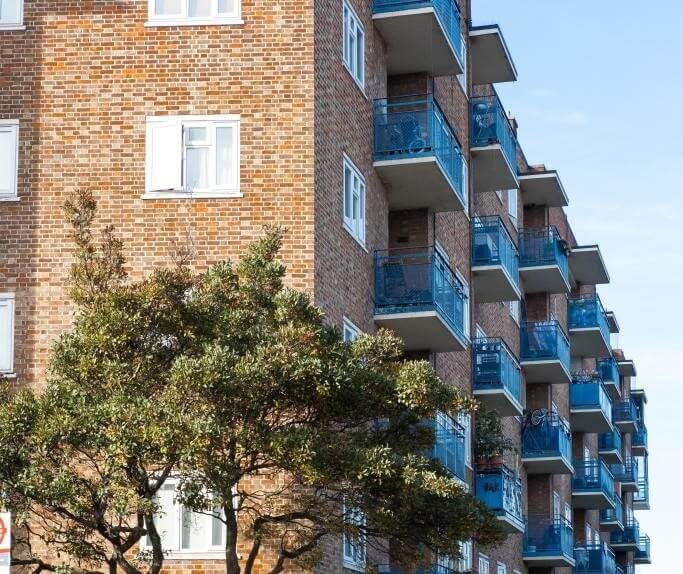Autumn of income shocks: the impact of removing Covid support

Findings from our new data-led analysis show how Covid support measures and falling rents have played a vital role in helping the most vulnerable Londoners cope financially through the pandemic. These support measures are now set to be removed whilst rents in the capital are projected to rapidly recover. This will mean that privately renting Londoners on Universal Credit will be, on average, £1,900 per year worse off by next year.
With the support of Trust for London, Policy in Practice has analysed administrative data covering nearly half a million low-income households across 15 London boroughs to show how the pandemic has affected Londoners on the lowest incomes.
The latest analysis from our groundbreaking Low-Income Londoners project compares data from each borough from before the pandemic in early 2020 through to the first three months of 2021, depending on data availability.
Administrative data tracks household income on a monthly basis, showing the economic impact of the pandemic in real-time. Unlike other analyses, this project focuses specifically on those with the lowest incomes who are therefore the most vulnerable to economic shocks.
In July, we published findings from the first report from the analysis, which focused on rising benefit caseloads and an increase in council tax support costs for local authorities.
The second report from the analysis explores the role of Covid support and the impact of the pandemic on out-of-work households, relative poverty, and housing affordability among low-income Londoners.
-
Download Phase Five, report 2: Impact of removal of Covid support and rising housing costs
-
Download Phase Five, report 1: Impact of Covid on caseloads and costs
New data-led analysis on Covid support: Three key findings
- The £20 per week uplift to Universal Credit, a fall in private rental costs, and a boost to housing support have kept many low-income Londoners out of poverty during the pandemic. Subsequently, the removal of the Universal Credit uplift, the refreezing of housing support and a projected rebound in private rents will leave privately renting households on Universal Credit an average of £1,900 per year worse off than they are now.
- The proportion of low-income households that are out of work has risen by 7% since before the pandemic, from 60% to 67%. This represents an average rise of over 1,800 households per borough in the study (11,820 out of work households per borough in Q1 2020 to 13,651 in Q1 2021). The ending of the CJRS from October is likely to cause many more households to become unemployed, further undermining the economic recovery for low-income Londoners.
- Households not in work, relative poverty and housing affordability vary considerably between boroughs. Boroughs have also seen different rates of change in these metrics since the start of the pandemic and what looks like stability across the city can mask significant local fluctuations.
These insights are visualised in our newly refreshed Living Standards Index for London dashboard. Councils are using the dashboard to understand the localised impact of the pandemic in their boroughs and to better target local support.
Short term stability is likely to precede a longer-term increase in poverty
Despite the economic shocks caused by the pandemic, a key finding of our latest analysis is that the percentage of households in the low-income dataset that are in relative poverty has remained stable at 32%, whilst the percentage of income spent on rental costs has reduced slightly, from 40% to 38%.
This is likely to be due to three factors:
- Covid support measures, in particular the £20 per week uplift to Universal Credit, have boosted the incomes of low-income households. The percentage of households in receipt of Universal Credit in the dataset that are below the relative poverty line decreased from 61% in Q1 2020, before the onset of the pandemic, to 53% in Q2 2020, after the Universal Credit £20 uplift had been introduced.
- The Local Housing Allowance, the maximum housing support available to private renters through the benefit system, was increased to meet the 30th percentile of local rents in April 2020. This reversed the cuts made to housing support in 2016 and improved housing affordability for those receiving housing benefit or Universal Credit
- The private rental market in London took a downturn during the pandemic. This meant that average rents for privately renting households in the dataset decreased by £71 per month between Q1 2020 and Q1 2021
Although this may sound like a tentatively positive outcome, the stability for low-income Londoners is likely to be short-lived. Paradoxically, low-income Londoners could become substantially worse off as the economy recovers. This is because the Universal Credit uplift is set to be removed in October 2021, the Local Housing Allowance has been refrozen from April 2021, and private rents are projected to rebound to at least their pre-pandemic levels in 2022.
This will mean that:
- Households on Universal Credit will lose £87 per month following the removal of the Universal Credit £20 uplift
- Low-income households who rent privately will pay £71 per month more, on average, in rent if rents recover to their pre-pandemic levels
- Housing support will not match any increase in rents for those with rents above the Local Housing Allowance
This combination of factors will cause a household on Universal Credit whose private rent is above the Local Housing Allowance to be an average of £1,896 worse off this time next year, even if the economy as a whole largely recovers.
The end of Covid support measures means a return to inadequate benefit support
As our previous research has shown, the £20 per week uplift to Universal Credit has played a significant role in keeping low-income households out of poverty during the pandemic. Whilst the government has framed this uplift as a generous, temporary boost to help people through the crisis, it in fact only reversed cuts introduced by the benefits freeze in 2016.
The removal of the uplift from October 2021 will represent a return to an inadequate level of benefit support whilst unemployment remains high and rising, and at the time many will rely on benefits for the first time as furlough and self-employment schemes end. We are therefore likely to see a jump in relative poverty for Universal Credit households from October and we will be monitoring this closely in the LSI dashboard.
The boost to housing affordability from the Local Housing Allowance increase and declining private rents is also likely to be short-lived. There are already signs that the private rental market in London is recovering from the second quarter of 2021 and it is expected to fully bounce back by next year. The refreezing of the Local Housing Allowance from April 2021 will mean that housing support will not match any rises in rents and will also decrease with inflation.
Low-income households with private rents above the Local Housing Allowance will therefore pay an average of £71 per month more in rent if private rents recover to their Q1 2020 levels. Privately renting households on Universal Credit, who will also lose £87 per month from the removal of the Universal Credit uplift, will therefore be nearly £1,900 per year worse off than they are now from these two changes alone.
In addition to this, many households who claimed Universal Credit for the first time in the past year will become affected by the benefit cap as their nine months’ grace period comes to an end. This will cause even further losses in income.
Data analysis gives councils actionable insights
Combined with persistently high unemployment, which will be worsened by the end of furlough in October, there is a danger that low-income Londoners could be left behind as the economic recovery progresses. This may lead to an increased need for local discretionary support and a further rise in CTS costs, putting even more pressure on councils’ budgets.
Our Living Standards Index dashboard will monitor economic realities for low-income households across London as this crucial stage of economic recovery from the pandemic unfolds. Councils can use these insights to inform and fine-tune their recovery plans in response to month-on-month changes. They can also benchmark outcomes for their low-income residents against other boroughs and city-wide averages, helping them to anticipate what further local support may be needed.
Timely responses to changes in economic realities for low-income households will be vital in navigating the uncertain next phase of the pandemic. Councils can gain household-level insights from their administrative data using our Low-Income Family Tracker (LIFT) to help them provide real-time, proactive responses to rapidly changing circumstances for their most vulnerable residents.
-
Download Phase Five, report 2: Impact of removal of Covid19 support and rising housing costs
-
Download Phase Five, report 1: Impact of Covid on caseloads and costs
Findings from earlier data-led analysis on low-income Londoners
Data can tell us what impact national and local policies are having on low-income households and help us design better interventions. This project shows what can be revealed when local authorities collaborate with their data. Tracking households over time tells policymakers what support is effective.
These latest data-led findings about the forthcoming Autumn of income shocks were featured in The Observer, Sunday 15 August 2021. Deven was quoted as saying,
By removing the pandemic’s protective measures too early the government is introducing an Autumn of income shocks to low income families. With the economy still well below pre-pandemic levels incomes and local economies are better protected by keeping these measures in place.
Read findings from previous research phases here.
- Phase 1: Poverty is dynamic
- Phase 2: Understand financial resilience
- Phase 3: Poverty changes over time
- Phase 4: Londoners are getting poorer
- Phase 5: The impact of Covid on low-income Londoners
Join our webinar: How Autumn’s income shocks will hit low-income families
Wednesday 29 September
The factors that have kept many low-income families out of poverty in the past year are changing, meaning many thousands will be worse off. In this webinar we will explore what the Autumn may bring for low-income households and how support organisations can work now to prevent hardship and prepare for an increased demand for services as Covid supports are withdrawn. We will be joined by Monica Kaur from the Money and Pensions Service. Find out more and register here






